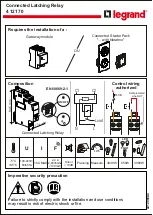
High Pressure
Sand Probe Relay
Model 1S04
Operation Manual
OMP # 1S04 6/09
I.
PRINCIPLE OF OPERATION
The Ruelco High Pressure Sand
Probe Relay Model 1S04 is an
instrument supply relay which uses a
thin wall probe installed directly into
a flowline to indicate that excessive
erosion and/ or corrosion has
occurred. It utilizes a reliable 3-way,
normally open valve that will bleed
off an instrumentation signal and
provide visual indication that the
probe has lost pressure integrity.
This alerts field personnel that
inspection of the flowline and
possible repair may be required. In
the open position, pneumatic
pressure coming into the “Inlet” port
flows through the body to the
“Outlet” port. The valve can be
manually tested by pulling the knob
outward, thus moving the shaft
assembly upward, and closing the
valve. When the relay is in the
closed position, the middle o-ring
blocks the pressure at the “Inlet” port
from flowing through, and the
”Outlet” can now be vented causing
the system to pressure down.
In the event of the thin-walled probe
breaking due to excessive wear, the
flowline pressure will push the shaft
assembly upward. This will cause
the relay to vent the “Outlet”
pressure while blocking the “Inlet”
pressure. At the same time a red
indication band will become visible
on the shaft to show loss of pressure
integrity.
II. INSTALLATION
The Model 1S04 Sand Probe Relay
can be mounted either vertically or
horizontally. If it is supported with
piping, care should be taken that the
strength of the pipe fittings used is
adequate to prevent the fitting from
breaking off in the relay body should
the relay be inadvertently struc
k
.
Proper pipe thread sealant should
be used on any pipe fittings
threaded into the relay ports. If
stainless steel fittings are used, a
sealant that will prevent galling is
required. Supply gas or hydraulic
fluid flowing through the relay should
be free of large dirt particles. If
compressed air is used, it does not
have to be lubricated. If natural gas
is used, it should contain as little
condensate as possible. This will
extend the life of the seals.
III.
DISASSEMBLY (REFER TO SPEC
SHEET 1S04)
Tools required are as follows:
•
7/16” open end wrench or
suitable adjustable wrench
•
1” open end wrench or
suitable adjustable wrench
•
1-3/8” open end wrench or
suitable adjustable wrench
•
7/8” open end wrench or
suitable adjustable wrench
•
Channel
lock
•
Pliers
•
Small sharp pick
A. DISASSEMBLY
1.
To replace the two (2) shaft
o-rings (Item 4) and the
piston seal (Item 11), the
relay does not have to be
completely disassembled.





















